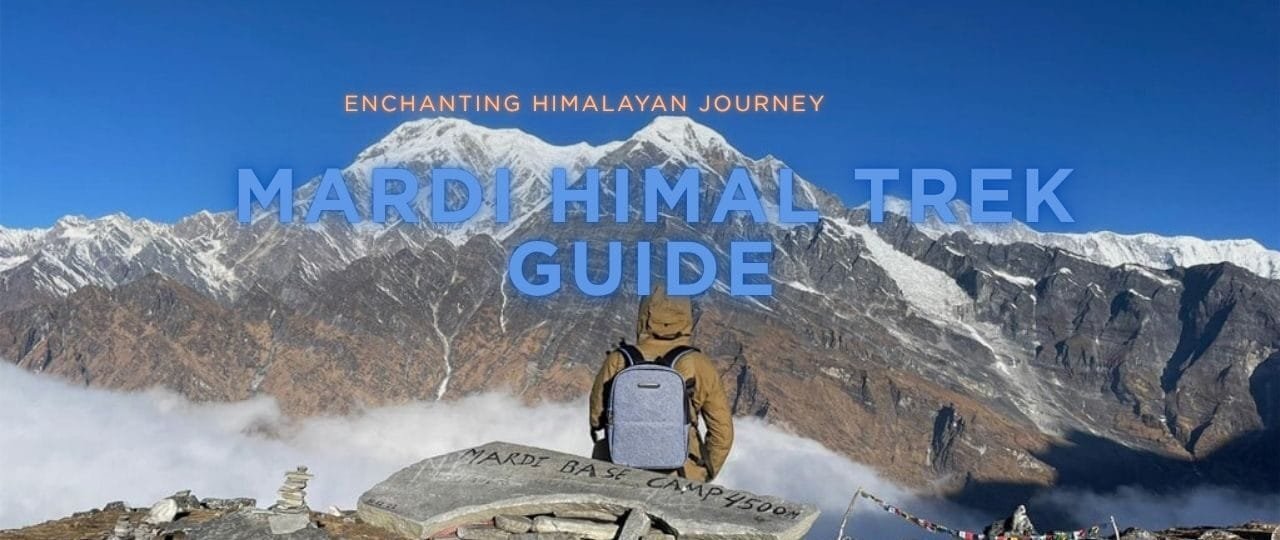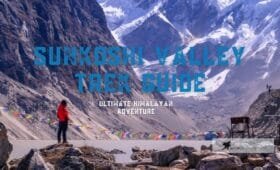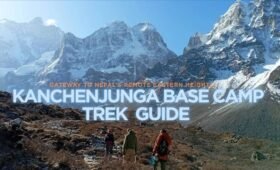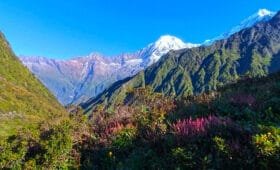The Mardi Himal Trek is a recent addition to Nepal’s trekking landscape, quickly gaining popularity for its serene trails, captivating views, and cultural encounters. Tucked in the Annapurna region, this route draws you away from the crowds of Annapurna Base Camp or Poon Hill. Instead, you’ll traverse quiet ridges, diverse forests, and small teahouse settlements before reaching panoramic vantage points. The Mardi Himal Trek Itinerary can be your ideal match if you’re craving an offbeat, scenic, and relatively short path.
This comprehensive Mardi Himal trek guide discusses everything from Trek Cost and recommended lodging to route maps, altitude tips, and the best time to go. We’ll also delve into the typical Mardi Himal Trek Difficulty, explore how to pick the right Mardi Himal Trek Package and provide insight into permits, gear, weather patterns, and volunteering opportunities through local communities. By the end, you’ll grasp the essential details—like Mardi Himal Trek Distance, practical advice on facing unpredictable Mardi Himal Trek Weather, and tips on the region’s culture. Ready to discover one of Nepal’s hidden gems? Let’s dive into the charm of Mardi Himal Trek.
1. Introduction: Why the Mardi Himal Trek?
Tucked beneath the mighty Machhapuchhre (Fishtail), the Mardi Himal Trek has emerged as a go-to for adventurers seeking quiet trails and mesmerizing sunrise vistas. The region remained relatively undiscovered until official route marking around 2012, and since then, more teahouses have sprouted to accommodate curious travelers. Yet the path maintains an uncrowded vibe, guaranteeing personal intimacy with nature.
Statistic: According to the Annapurna Conservation Area Project, fewer than 15,000 trekkers attempted the Mardi Himal route in 2022—far lower than the 60,000–70,000 who do the Annapurna Circuit yearly. This disparity ensures solitude along forest ridges and vantage points, letting you savor each step unhurried.
Quote:
“I wanted a trek that combined culture and raw Himalayan beauty without major crowds. Mardi Himal Trek delivered perfectly,” says Sarah, a 29-year-old from Canada who completed the route last spring.
2. Historical & Cultural Overview
Mardi Himal is a lesser-known peak in the Annapurna region. Its name traces back to local Gurung communities who dwell near the lower stretches, sustaining themselves through farming and seasonal tourism. The concept of a formal route blossomed only about a decade ago. Before that, shepherds and local villagers alone knew these hillside pathways.
Many teahouses remain family-run, offering glimpses of rural Nepali life. Villagers often recount how only a trickle of independent trekkers ventured through during the route’s early days. Today, the region is recognized for its hospitality, making each rest stop a chance to chat about cultural traditions, culinary habits, or local lore.
Itinerary
3. Key Highlights of Mardi Himal Trek Itinerary
A standard Mardi Himal Trek Itinerary runs 5–7 days, but the route can extend to 8–9 if you add side trips or cultural immersions. Below is a concise blueprint:
- Day 1: Pokhara → Kande → Forest Camp
A one-hour drive leads from Pokhara to Kande (~1,770m). Hike steadily uphill through farmland and blossoming rhododendron groves. Most people break overnight at Forest Camp (~2,600m), called Kokar. - Day 2: Forest Camp → Low Camp (3,050m)
Ascend deeper into cloud forests. Watch for occasional glimpses of Machhapuchhre peeking above. Lodging at Low Camp is modest but scenic. - Day 3: Low Camp → High Camp (3,580m)
It is a short yet steep climb, passing Middle Camp around ~3,300m. Ridge-line walks deliver panoramic views of Annapurna South and Machhapuchhre. High Camp teahouses often have limited rooms, so arrive early. - Day 4: High Camp → Mardi Himal Base Camp (4,500m) → High Camp
The trek’s highlight is an optional day hike to Mardi Himal Base Camp (~4,500m). This vantage point reveals a 360° ring of Himalayan giants. Return to High Camp by afternoon. - Day 5: High Camp → Sidhing Village (1,700m)
Descend a varied path less trodden than the main route. Siding offers a tranquil village experience. - Day 6–7: Return to Pokhara
You can walk or catch a jeep from Sidhing or Lumre to Pokhara. Some spend an extra day exploring local villages or volunteering with community projects.
Mardi Himal Trek Duration rarely exceeds a week, but if you incorporate homestay experiences or cultural tours, you can easily extend it.
4. Understanding the Mardi Himal Trek Difficulty
The Mardi Himal Trek is generally moderately complex. Elevation near 4,500m at Base Camp demands prudent acclimatization, but daily ascents rarely exceed 600–800m. Trails weave through forests, ridges, and rocky sections near High Camp.
Fitness:
- Essential cardio (running, cycling) for at least 3–4 weeks pre-trek.
- Light altitude experience helps. If you’re new, go slowly above 3,000m and stay hydrated.
- Some stone step climbs can be steep, but the short daily distance reduces exhaustion.
Altitude sickness remains possible around 4,000m. If a headache or dizziness arises, rest at High Camp or descend slightly until symptoms ease.
5. Mapping Your Route: A Look at the Mardi Himal Trek Map
A Mardi Himal Trek Map typically identifies:
- Trailheads: Kande or Phedi near Pokhara, with expansions from Ghalel or Lumre.
- Camps: Forest Camp (~2,600m), Low Camp (~3,050m), Middle Camp (~3,300m), High Camp (~3,580m).
- Base Camp: ~4,500m, though signboards sometimes read 4,500–4,600m.
- Descent: Usually via Sidhing or Kalimati for a less-crowded route out.
Some digital maps also highlight vintage corners that are perfect for sunrise or photography. Since the route can be steep or muddy, a Mardi Himal Trek guide’s local knowledge often supersedes any map.
6. How Much Does It Cost? Explaining the Mardi Himal Trek Cost
Mardi Himal Trek Cost is generally moderate:
- Permits:
- ACAP (Annapurna Conservation Area Permit): ~USD 30.
- TIMS card (~USD 20–30) if trekking independently.
- Transport:
- Pokhara to Kande bus or taxi: ~USD 1–25, depending on style.
- Return from Sidhing or Lumre by jeep: ~USD 10–30.
- Teahouse Lodging & Meals:
- Basic rooms: ~USD 3–5 per night.
- Meals: ~USD 15–25 daily for three meals, tea, and occasional snacks.
- Guide / Porter (Optional):
- Guide: ~USD 25–35/day. Porter: ~USD 15–25/day.
A minimal self-managed trek might cost ~USD 200–300 for 5–7 days, while a complete Trek Package with a Mardi Himal Trek Guide, lodging, transport, and some meals can be ~USD 400–600, depending on comfort levels.
7. Booking the Right Mardi Himal Trek Package
Agencies in Pokhara or Kathmandu frequently offer Mardi Himal Trek Package deals. These can bundle permits, lodging, certain meals, Mardi Himal Trek Guides, and transportation to/from the trail. Evaluate:
- Group vs. Private: Group treks lower costs but fix schedules. Private tours let you shape daily pacing or side ventures.
- Gear Inclusions: Some packages provide sleeping bags, jackets, or hiking poles. Check if this saves you from renting.
- Volunteering Add-ons: Some trek plus volunteer combos let you help local schools or environment projects.
8. Securing Mardi Himal Trek Permits
Although not a restricted zone, you still need:
- Annapurna Conservation Area Permit (ACAP): ~USD 30.
- TIMS Card: ~USD 20–30 if going solo, ~USD 10 if organized.
Present your passport, visa, and passport photos at the Nepal Tourism Board in Kathmandu or Pokhara’s Permit Office. Keep the permit slips for inspection by rangers near Kande or as you climb.
9. Mardi Himal Trek Best Time: Seasons & Weather
Because Mardi Himal Trek Weather can shift rapidly on ridges, timing is crucial. The region remains accessible most of the year, but conditions vary:
- Autumn (Sept–Nov): Crisp, stable skies, mild ~15–20°C daytime below 3,000m. Nights approach freezing at High Camp—peak crowd season.
- Spring (Mar–May): Rhododendrons bloom. Days are moderately warm, but clouds might gather in the afternoons; there is magical forest color and fewer crowds than autumn.
- Winter (Dec–Feb): Clear but cold. High Camp nights can plummet below s-5°C. Snow might hamper paths to Base Camp.
- Monsoon (Jun–Aug): There are frequent rains in lower sections, leading to slippery trails and leeches. The route sees fewer trekkers, though misty scenes can feel mystical.
10. Hiring a Mardi Himal Trek Guide
A guide isn’t mandatory for Mardi Himal, but a Mardi Himal Trek Guide enriches your experience:
- Local Navigation: Helps if fog envelops ridges or if side routes beckon.
- Cultural Insight: They interpret local interactions, share folklore, and foster closeness with villagers.
- Safety: Mardi Himal Trek Guides handle emergencies—like altitude sickness or injuries—and can expedite rescue.
Daily rates range from USD 25–35, plus tips. A porter adds USD 15–25/day. Many find guides valuable, especially if they’re new to trekking or want a deeper cultural dimension.
11. Preparation & Tips for Success
11.1 Physical Training
- Cardio: Running, biking, or swimming at moderate intensity for 4–6 weeks is sufficient.
- Strength: Weighted step-ups or lunges help with uphill climbs, especially near High Camp.
- Flexibility: Light stretching post-hike prevents muscle tightness.
11.2 Gear & Clothing
- Layers: T-shirt, mid-layer fleece, waterproof jacket, warm hat, gloves.
- Footwear: Broken-in boots with decent ankle support.
- Miscellaneous: Headlamp, refillable water bottle, small medical kit, trekking poles (if you prefer them).
11.3 Mindful Acclimatization
Though the maximum Mardi Himal Trek Altitude near Base Camp is ~4,500m, mild altitude sickness can occur. Drink 3L water daily, ascend gradually, and rest if you get headaches or dizziness.
12. Stories from the Trail: Testimonials & Inspiration
Hannah’s Journey
Hannah, a 28-year-old nurse from Germany, recounts her experience: “The ridges near High Camp felt surreal—clouds dancing beneath my feet. The sense of personal accomplishment soared when I glimpsed Machhapuchhre’s near-vertical face. The trek’s intimacy overshadowed any challenges.”
Local Connection
Rajesh, who operates a teahouse at Low Camp, explains: “When trekkers come, they often ask about volunteering or donating items to local schools. It’s wonderful that outsiders care about our community’s growth while enjoying nature.”
FAQs
13. Seven Most Frequently Asked Questions
What is the typical Mardi Himal Trek Duration?
Usually, 5–7 days, though some wrap up in 4 days or extend to 8–9 days if exploring side trails.
How difficult is the Mardi Himal Trek Difficulty?
It’s moderate. The short path includes steep ascents to High Camp (~3,580m) and a base camp day hike near 4,500m.
How much does the Mardi Himal Trek Cost?
If you go solo, budget ~USD 200–300 for permits, food, and lodging. A mid-range Mardi Himal Trek Package can cost ~USD 400–600.
When is the best time for the Mardi Himal Trek?
Autumn (Sept–Nov) and spring (March) for stable weather and clear summits. Winter is quieter but chilly, while monsoons see frequent rain and mist.
Do I need a guide for the route?
It is not legally required, but a Mardi Himal Trek guide (~USD 25–35/day) can enhance safety, local insight, and route clarity.
Which permits are necessary?
ACAP (~USD 30) plus a TIMS card (~USD 20–30) for independent trekkers. A local municipality fee sometimes applies if you exit near Ghandruk.
What is the maximum Mardi Himal Trek Altitude?
Mardi Himal Base Camp stands at about 4,500m. High Camp sits near ~3,580m.
14. Conclusion
The Mardi Himal Trek combines Himalayan wonder with an intimate vibe and is short, scenic, and culturally rich. You’ll meander through rhododendron forests, ascend narrow ridge lines, and greet Machhapuchhre’s mighty face at dawn. Mardi Himal Trekking deserves your attention if you’re a novice wanting a less-crowded route or an experienced trekker seeking a fresh angle on the Annapurna region.
Partner with ViN for Meaningful Travel
At Volunteers Initiative Nepal (ViN), we aim for meaningful journeys blending exploration with empathy:
Share: Spread your story—spur others to transform their treks into catalysts for local upliftment.
Volunteer: Day teaching youth or assisting local environment drives around Kaski.
Intern: Conduct fieldwork supporting local research or socio-economic studies.
Donate: Contribute to programs building educational or healthcare frameworks in Himalayan villages.
Namaste, and let’s collectively shape a future where trekking fosters personal transformation and communal prosperity. Travel can be more than a vantage point for sunrise—it can be a stepping stone to uplifting entire villages across Nepal.
Additional Information
Additional Info & Practical Tips
We’ve covered the fundamentals of Mardi Himal Trek. Yet, there’s more to optimize your experience. Below are extra insights about the route, local culture, volunteering aspects, and gear:
1. Seasonal Breakdown & Mardi Himal Trek Weather
1.1 Autumn (Sept–Nov)
- Crisp skies, mild days (~15–20°C in lower segments), and sub-zero nights near High Camp.
- Stunning clarity for sunrise views of Annapurna South, Hiunchuli, and Machhapuchhre.
1.2 Spring (Mar-May)
- Rhododendron forests bloom, painting hillsides red and pink.
- Temperatures are comfortable, though clouds might gather after midday. Great for flower photography.
1.3 Winter (Dec–Feb)
- There is less trekking traffic but chilly nights. High Camp can see -5°C or below. Some teahouses might close if snowfall hits.
1.4 Monsoon (Jun–Aug)
- Daily showers in the afternoons make trails muddy and slippery.
- Unexpected clear windows reveal moody, cloud-draped ridges.
2. Cultural Immersion En Route
2.1 Gurung & Magar Traditions
These ethnic groups inhabit lower stretches, especially near Kande or Ghandruk, if you adapt your route. Observing local handicrafts or festivals can add cultural depth.
2.2 Lodging & Family Teahouses
Mardi Himal Trek Accommodations typically are small teahouses. Chatting with hosts reveals how their families built new lodges after Mardi Himal’s route officialization. Purchasing local crafts or donating school supplies fosters rapport.
3. Potential Side Trips
- Base Camp Exploration: Some ascend above the official “viewpoint” to ~4,500m for an even grander perspective. This path, though not heavily marked, demands caution.
- Ghandruk Extension: Some conclude in Ghandruk, linking with the Ghorepani Poon Hill route. This synergy suits trekkers wanting a deeper Annapurna immersion.
4. Water & Food Advice
4.1 Drinking Water
Carry purifier tablets or a Steripen. Teahouses sell boiled water for ~USD 0.5–1 per liter, helping you reduce plastic bottle usage.
4.2 Meal Costs & Variety
Expect dal bhat, chowmein, momo, chapati, and some Western breakfasts like pancakes or porridge. Most teahouses offer warm ginger or black tea for ~USD 1–2 per cup.
5. Health & Safety Essentials
- Altitude Precautions: Above 3,000m, ascend gradually. Rest or descend if you sense acute headache, dizziness, or breathlessness.
- Insurance: Ensure coverage for trekking up to 4,500m. Some standard plans exclude high-altitude rescue, so read the fine print.
- Emergency: A helicopter rescue from Middle Camp or Low Camp is possible, but only if the weather allows. A Mardi Himal Trek guide or lodge owner can help coordinate.
6. Volunteering with ViN
6.1 Pre- / Post-Trek
Spending a day or two at a local school near Pokhara or Kaski District can add philanthropic touches to your holiday. Volunteers might teach English or share environmental awareness tips.
6.2 On-Trek
Some villages welcome short skill-sharing sessions in the afternoons if arranged in advance. This fosters immediate cultural bridges. Activities might include basic tutoring or environment clean-up drives.
7. Common Trekking Challenges & Overcoming Them
- Steep Trails: Sections to High Camp test leg endurance. Pace yourself, and use trekking poles if they are helpful.
- Teahouse Overcrowding: Autumn might see a rush at High Camp. Arrive by early afternoon or request your Mardi Himal Trek guide to phone ahead for lodging.
- Variable Weather: Fog can cloud ridges. Adapting your daily plan or waiting out a storm might be necessary.
8. Distilling the Experience
The The Mardi Himal Trek Route is short, but the emotional or spiritual payoff can be huge. The vantage near Base Camp at ~4,500m reveals face-to-face proximity with Machhapuchhre, swirling clouds below, and serenity rarely matched by busier treks.
Inspiring Success Story:
Mark, a 35-year-old teacher from the US, combined his Mardi Himal trek with a short volunteering stint in Ghandruk, teaching English to local kids. He recalls the synergy post-trek: “Every day on the ridge came alive, knowing I was also investing in the next generation’s education. This interplay gave deeper meaning to each panorama.”
Practical Details
Deep Dive: Extra Practical Details & Insights
1. Weather Patterns & Seasonal Gear
1.1 Autumn
- Daytime temperatures are around 15–20°C in lower altitudes, and nights are near freezing at High Camp. Clear mornings are followed by a potential haze by midday.
- Gear: Medium-duty sleeping bag rated ~0°C, layered clothing—UV-protective sunglasses for crisp skies.
1.2 Spring
- Warmer, significantly below 3,000m. Fewer morning clouds.
- Blooming rhododendrons color the route. In late spring, occasional thunderstorms might occur.
1.3 Winter
- Clear but cold. If unexpected snowfall hits, the path beyond High Camp can get icy.
- Some teahouses close at High Camp or reduce staff. Confirm in Pokhara first.
1.4 Monsoon
- Afternoon rains. Early morning hiking helps dodge heavy downpours.
- Gaiters or quick-drying gear are recommended for muddy steps.
2. Teahouse Etiquette
2.1 Menu Variation
Meals revolve around dal bhat, chow mein, or Tibetan bread. Expect limited variety at higher altitudes. Stocking up on chocolate bars in Pokhara helps if you crave sweets.
2.2 Communal Dining
Evenings often see travelers gathering around a central stove, exchanging stories. This fosters camaraderie among different nationalities.
3. Potential Trekking Combinations
- ABC Combo: Some trekkers link Mardi Himal with Annapurna Base Camp for a ~12-day itinerary. This synergy demands more stamina but amplifies your Himalayan perspective.
- Ghorepani Extension: Another idea merges Ghorepani Poon Hill and Mardi Himal for an ~8–10 day loop, letting you enjoy two famed vantage points.
4. Impact of Trekking on Local Communities
Tourism revenue can enhance village infrastructure—like building safer footbridges or improving child education resources. By choosing local teahouses, you keep profits in the communities. Also, avoiding plastic bottles and supporting lodge-driven waste disposal helps maintain the route’s natural allure.
5. Reflection & Return
After concluding the trek near Sidhing or Kalimati, a short jeep ride brings you back to Pokhara. Many travelers spend a day or two unwinding at Phewa Lake or indulging in lakeside cafes. Others explore volunteering to extend their synergy with local folks. Journaling your experiences fosters a deeper understanding of the cultural and natural wonders you’ve encountered.




